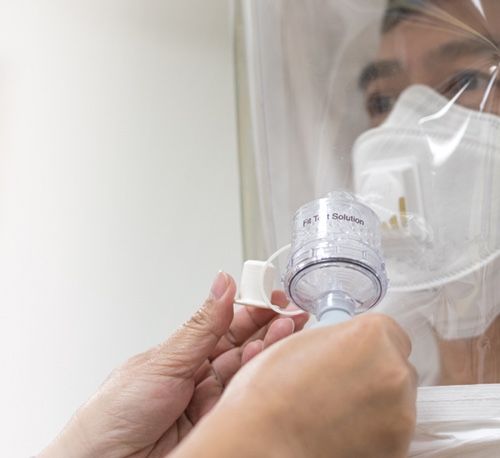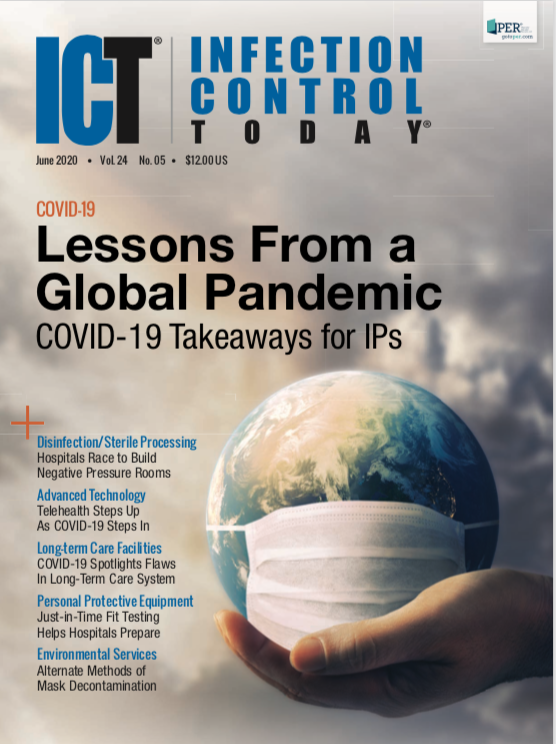Just-in-Time Fit Testing Allows for Rapid Response During Pandemics Like COVID-19
Just-in-time (JIT) fit testing allows a healthcare organization to offer evaluation, training, and fitting of HCPs during rapid intervals, as needed, based on specific patient care assignments.

The topic of appropriate personal protective equipment (PPE) is continuously in the media and trade articles thanks to the COVID-19 pandemic. PPE supply and use is a daily topic for those who work in infection prevention and one of the main tools used to prevent the spread of infection in healthcare facilities. The use of N95 respirators, and their equivalent, is currently a subset of the PPE focus that has many facilities scrambling to provide the best PPE available to staff and keep their stock in hand.
Respiratory protection programs mandated by the Occupational Safety and Health Association (OSHA) include the process of training, providing medical clearance, and fit testing for respirator use in healthcare facilities. These programs are often run by an occupational or employee health department in collaboration with safety, emergency management, infection prevention, and human resources. Several requirements include ensuring that health care providers (HCP) know how to use respirators, how to don and doff appropriately, when to use the respirator, and how to maintain their PPE to maximize the lifespan of that respirator.
Traditionally, these are accomplished via an annual fit test through occupational health, which is done for HCPs who may have contact with infectious agents that require airborne precautions (ie, tuberculosis, measles, chicken pox).
Typically, the fit testing depends on the annual anniversary of hire date, department-specific dates for testing, or some other pre-determined timeframe to have staff come through on a scheduled basis so as to not overwhelm the occupational health department. In a pandemic situation of a respiratory illness, when many staff members need to have quick access to appropriate respirators, the process for fit testing has to change to a different model of operationalization.
Just-in-time (JIT) fit testing allows a healthcare organization to offer evaluation, training, and fitting of HCPs during rapid intervals, as needed, based on specific patient care assignments. Many institutions have JIT fit testing as part of their plans for pandemic influenza or Ebola preparations. In order to implement JIT programs, many key components need to be considered. Also, in March 2020, OSHA issued a temporary guidance that allows healthcare facilities to suspend annual fit testing due to shortages, as long as staff have a prior fit test with the same model respirator.1 This allows for JIT fit testing to be accomplished for staff in a rapid pace needed to keep up with patient care needs.
Another way to better implement JIT fit testing is to utilize qualitative test methods versus quantitative. The more commonly used qualitative method involves the use of a sweet, saccharin solution sprayed into a hood while the HCP wears the respirator. If the HCP can taste the sweet solution, then essentially, they fail the fit test for that respirator.
Quantitative fit testing involves modifying the respirator to allow access for a sampling port, therefore damaging the respirator so that it cannot be used after the fit test. Again, in recognition of PPE shortages (so glaringly revealed during the COVID-19 pandemic), OSHA recommended using qualitative fit testing over quantitative to conserve respirators and making JIT more feasible. OSHA did so in the same March 2020 temporary guidance.
Occupational health programs historically control the fit testing process. However, in an emergency situation, occupational health would likely not have the capacity to offer JIT fit testing at all times for HCPs, therefore a cadre of staff need to be trained into the roles and assigned a schedule to have the service available 24/7.
Occupational health departments can train staff, make sure they are certified to teach the process, thereby making a labor pool of fit testers available in the facility for the times and days needed. Often in pandemics-and, again, as we’ve seen recently with COVID-19-job roles need to be adjusted, so there may be staff from low work-load areas that comprise the JIT fit testing team.
Having this resource staffed consistently meets the needs of HCPs and can reduce the anxiety about finding the appropriate size mask in a moment. Another method of training staff for fit testing that has been shown to be effective is through a video.2 If occupational health is not available, or there are a large number of locations and staff that need training, having a video option for training with a competency would be a reasonable alternative.
Part of the JIT process needs to include a tracking mechanism for staff. Having a searchable database of all the sizes that staff have fitted would be a helpful tool. Along with a database that is kept by the JIT program staff, develop a way for staff to also track their own mask types and sizes that they can fit. This can be accomplished by having a sticker or badge accessory so that staff will always have it written on their badges and available whenever at the facility. During pandemic situations, the usual masks that an organization uses for annual fit testing and patient care may not be available, so new products will be brought in regularly as alternatives. Having a log of which sizes work for HCPs and also a document that shows comparable products that tend to be similar in size is helpful as well to decrease guessing and wasting masks that may not fit staff.
Similarly, working with logistics support to review the options available for respirators, tracking usage and days on hand, projecting volumes, estimating how a surge of a certain percentage would impact supply, and reporting those data regularly creates a successful program. Other supplies needed for JIT include the hoods or test kit components and the saccharin or bitter testing solution. During pandemics, these supplies can also be in high demand and integrating those into the tracking helps prevent any unforeseen delays in JIT testing.
Part of the JIT process is to prioritize or delineate the HCPs who would need to use respirators. This can be accomplished by looking at job roles and departments that would interact with patients who require airborne precautions and tasks that are done by the various job roles. Cross training staff, such as having nurses perform phlebotomy or administer nebulizing treatments, can limit staff who need to interact with patients in airborne precautions when PPE are in demand.
Also, adjust when some processes should be implemented. For instance, only have the room cleaned by housekeeping after discharge. In addition, wait the allotted time for appropriate air exchanges in the room so that environmental services staff won’t need to don N95 respirators to perform their duties. Also, cohort patients and staff so that the JIT fit testing can be focused on that select group who will have the most need.
The use of JIT fit testing is essential to providing HCPs with the appropriate PPE during outbreaks, pandemics, and emergent respiratory illness disasters. Part of the planning for emergency preparedness can involve developing JIT guidelines and program guidance so that can be used in training and be available when the next outbreak occurs. Currently, many organizations are using JIT testing as part of their response to the COVID-19 pandemic. Documentation of operations of those programs will be key and any lessons learned from current experiences can be utilized for future planning.
Rebecca Leach, RN, BSN, MPH, CIC, has been an infection preventionist since 2010, with a background in nursing and epidemiology. Leach, a regular contributor to Infection Control Today®, currently works at a healthcare system in Phoenix that includes 5 hospitals and more than 100 outpatient treatment centers.
References:
1. US Department of Labor, Occupational Safety and Health Administration. Temporary enforcement guidance-healthcare respiratory protection annual fit-testing for N95 filtering facepieces during the COVID-19 outbreak. https://www.osha.gov/memos/2020-03-14/temporary-enforcement-guidance-healthcare-respiratory-protection-annual-fit
2. Harper et al. Comparison of three respirator user training methods. J Occup Environ Med. 2013 Dec;55(12):1484-8.

“Ongoing Assault”: How HHS Layoffs Have Eviscerated Infection Prevention Support Across the Nation
April 1st 2025Mass layoffs at HHS and CDC have gutted critical infection prevention programs, leaving frontline professionals overwhelmed, under-resourced, and desperate to safeguard public health.
Unmasking Long COVID: Dr Noah Greenspan on Recovery, Research Gaps, and the Future of Treatment
March 18th 2025Dr Noah Greenspan discusses the evolving understanding of long COVID, current treatment strategies, diagnostic challenges, and the critical need for research and awareness in post-viral syndromes.